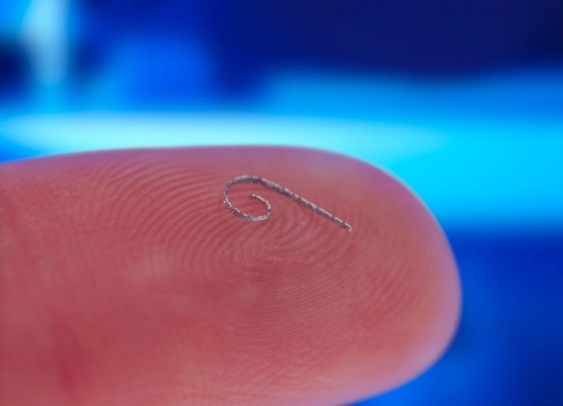Ear implants with a memory

This laser-additive manufactured micro-actor for cochlea implants can change its shape due to temperature changes. Foto: LZH
The challenge, however, is to print highly precise and small prints which are, on top of that, made of difficult-to-process materials. The scientists at the Laser Zentrum Hannover e.V. (LZH) are conducting research on that very topic.
At the Hannover Messe 2014, they will demonstrate how they use the laser to manufacture tiny implants with a memory function or complex shapes, such as the cochlea of the human inner ear.
In the field of medical technology Laser Additive Manufacturing (LAM) opens up new ways of healing, e.g. for hearing-impaired persons. Inserting an implant into the tiny cochlea requires utmost care.
During the procedure the surgeon runs the risk of destroying intact sensory cells which would even further decrease the hearing ability of the patient.
The micrometer-small cochlea replicas that the surgeons use to practice the procedure are manufactured by the LZH’s Photonic System Technology Group using the LAM technology. The Surface Technology Group at LZH goes one step further.
In cooperation with the Hannover Medical School (MHH), they are developing implants that change their shape due to temperature changes during the surgery and shall thus make the insertion much easier.
Using printed Magnesium to reconstruct faces
LAM also allows for the manufacturing of temporary implants. These Magnesium scaffolds are slowly and gradually decomposed by the human body.
They are well suited for reconstructing defects of the facial skull, because their shape can be matched to the face of the patient. Directly after the surgery, the bioresorbable implants stabilize the tissue above. Afterwards, they make room for new bone cells.
Tiny, highly complex parts, however, not only inspire innovations in biomedical technology. There are practically no limits to their use. Polymers or metals, for example, can be used.
Even complex parts with internal openings can be manufactured rapidly and with high precision. Only a 3D drawing is required.
For more information about Laser Additive Manufacturing visit the LZH at the Hannover Messe: Lower Saxony Pavilion, hall 2, stand A08.
http://www.lzh.de/en/hannovermesse2014 – more information about LZH at the Hannover Messe
Media Contact
All latest news from the category: HANNOVER MESSE
Newest articles

Red light therapy for repairing spinal cord injury passes milestone
Patients with spinal cord injury (SCI) could benefit from a future treatment to repair nerve connections using red and near-infrared light. The method, invented by scientists at the University of…

Insect research is revolutionized by technology
New technologies can revolutionise insect research and environmental monitoring. By using DNA, images, sounds and flight patterns analysed by AI, it’s possible to gain new insights into the world of…

X-ray satellite XMM-newton sees ‘space clover’ in a new light
Astronomers have discovered enormous circular radio features of unknown origin around some galaxies. Now, new observations of one dubbed the Cloverleaf suggest it was created by clashing groups of galaxies….





















